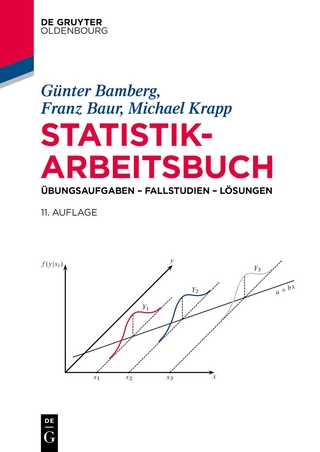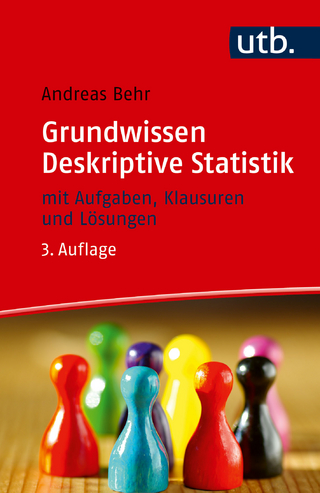
Stochastic Processes
Springer-Verlag Berlin and Heidelberg GmbH & Co. K
978-3-540-03629-6 (ISBN)
- Titel ist leider vergriffen;
keine Neuauflage - Artikel merken
These models must not be too general, for in that case not only would their theoretical study prove difficult, but above all the adaptation of such models to an observed system would lead to an estimation of a great number of parameters on the basis of a necessarily restricted sample. This would constitute an insuperable difficulty for the practical scientist. It is therefore essential for him to have at his disposal a varied range of very characteristic models.
I Introduction.- 1. Examples.- 2. Definitions.- 3. Classification according to the nature of E.- 4. Classification according to the nature of the set T of instants where the system is observed.- II Poisson processes.- A. Generalities - Point processes.- 1. Definition.- 2. Point processes.- 3. Definition of a point process.- B. The uniform Poisson process.- 4. Definition of the Poisson point process.- 5. Distribution of the random interval between two consecutive events.- 6. Conclusion.- 7. The Gamma probability distributions.- 8. Distribution of " survival " of an interval that obeys ?1.- 9. Distribution of the interval embracing (k+1) consecutive events.- 10. Probability distribution of the number of events occurring in a given interval of time.- 11. Second stochastical definition of the Poisson process.- 12. Conditional distributions.- 13. Number of occurrences in an interval of random length.- C. Probability distributions associated to Poisson processes.- 14. Poisson distribution.- 15. Gamma distribution.- 16. Beta distributions.- D. Extensions: Poisson-type-processes.- 17. Continuous, non-uniform Poisson processes.- 18. Poisson-type processes.- 19. Parameter-distribution.- 20. Decomposition ot the parameter distribution.- 21. Interval distribution and conditional distributions.- 22. Poisson cluster process.- Problems for solution.- Random functions associated to a Poisson process.- III Numerical processes with independent random increments.- 1. Definition.- 2. Mean values - zero mean process.- 3. Variance distribution.- 4. Cumulants and second characteristic functions.- 5. Indicator function of a Poisson process.- 6. The Wiener-Levy process.- 7. Laplace processes with independent increments.- 8. General form of the random functions X (t) with independent increments.- 9. Infinitely divisible distributions.- 10. Stable distributions.- Problems for solution.- IV Markov processes.- A. Generalities and definitions.- 1. Generalities.- 2. Notation.- 3. Representation by temporal development.- 4. Markov sequences.- 5. Probability law of states.- 6. Homogeneous Markov sequences.- B. Study by means of convexity.- 7. Limit for k = ? of Mk when all the terms of M are positive.- 8. Regular positive case.- C. Study by means of spectral analysis.- 9. Definitions.- 10. Eigenvalues and eigenvectors.- 11. Properties of the eigenvalues of a Markov matrix.- 12. Canonical representation.- D. Direct algebraic study.- 13. Classification of states.- 14. Order on classes: transient classes and final classes.- 15. Examples.- 16. Summary.- E. Reaching delays and sojourn duration problems.- 17. Introduction.- 18. Example.- 19. General method.- F. Miscellaneous.- 20. Ergodicity:.- 21. Inversion of a homogeneous Markov sequence.- Problems for solution.- V Laplace processes and second order processes.- 1. Introduction.- A. Second order properties.- 2. Second order processes.- 3. Stationary second order processes.- B. Laplace processes.- 4. Definition.- 5. Reminder of a few definitions and properties concerning Laplace random sets (or Laplace random vectors) of k dimensions.- 6. Covariance Function of a Laplace process.- 7. Discrete process - Levy canonical decomposition.- Problems for solution.- VI Some Markov processes on continuous-time.- 1. Homogeneous Laplace-Markov sequences.- 2. Stationary Laplace-Markov sequence.- 3. Estimation problems.- 4. Interpolation - permanent process.- 5. Non homogeneous standardized Laplace-Markov processes.- 6. General form of Laplace-Markov processes.- 7. Wiener-Levy processes.- 8. Poisson-Markov processes.- Problems for solution.- Answers to problems.
| Erscheint lt. Verlag | 1.1.1966 |
|---|---|
| Reihe/Serie | Okonometrie und Unternehmensforschung. Econometrics and Operations Research ; 3 |
| Zusatzinfo | 5 black & white illustrations, biography |
| Verlagsort | Berlin |
| Sprache | englisch |
| Gewicht | 410 g |
| Themenwelt | Mathematik / Informatik ► Mathematik |
| Wirtschaft ► Volkswirtschaftslehre ► Ökonometrie | |
| ISBN-10 | 3-540-03629-6 / 3540036296 |
| ISBN-13 | 978-3-540-03629-6 / 9783540036296 |
| Zustand | Neuware |
| Haben Sie eine Frage zum Produkt? |
aus dem Bereich


